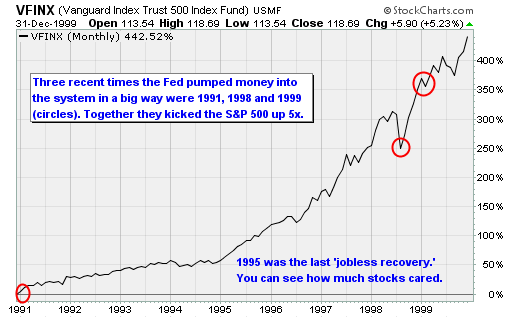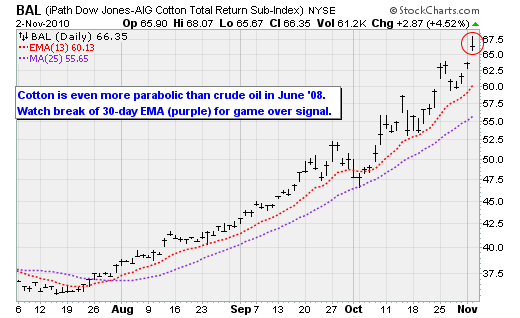Stock Market At Critical Juncture
Stock-Markets / Stock Markets 2010 Nov 08, 2010 - 05:49 AM GMTBy: Money_Morning
 Jon D. Markman writes:
Stocks rose gently like heat waves off a radiator over the past week, as traders guessed, assessed and processed the results of the midterm elections and the Federal Reserve's decision to try to light a fire under the U.S. economy by buying a $75-billion pile of fresh, new Treasury bonds every 30 days for the next eight months.
Jon D. Markman writes:
Stocks rose gently like heat waves off a radiator over the past week, as traders guessed, assessed and processed the results of the midterm elections and the Federal Reserve's decision to try to light a fire under the U.S. economy by buying a $75-billion pile of fresh, new Treasury bonds every 30 days for the next eight months.
The major indexes rose 3.5% amid a set of sessions when banks finally found footing, as they were the best performing group, up 1%. Laggards were industrials and utilities, ending flat. Breadth was positive, favoring advancers by 2-1. And the number of new highs swelled to 1,200 while new lows also rose, to 80.
Technically the market is at a very important juncture. Stocks have treated the 1,220 level as if it were an electric fence for the past two years. First it was the original bear-market low in July 2008 after the government said it would back the reeling banks Fannie Mae (NYSE: FNMA) and Freddie Mac (OTC: FMCC). Second, it was the spot through which stocks fell in September 2008 after the Lehman Brothers collapse. Third, stocks topped here in April following the BP oil well blowout and SEC indictment of Goldman Sachs Group Inc. (NYSE: GS). And now here we are again.
Bears think #3 will repeat and stocks will collapse back into a black pit of despair. My expectation is that there is potential for an upside version of #2, with stocks pushing up toward 1,400. I have said that banks, chip makers and energy companies would have to get in gear for that to happen -- and now, amazingly enough, that is happening, now that political, monetary and economic uncertainties are firming up. Make sure you are properly positioned.
One caveat before we move on: If this 1,220 test fails, then all bets are off. The next week is critical. Stay on your toes.
THE WEEK
Wednesday provided a streak of jubilation for Republicans, bravado for Tea Partiers and humility for the Democrats, though none of it will affect stock prices much. My experience shows that inertia, the bureaucracy and lobbyists really run the show in Washington and politics has way less impact than most believe.
Here's what you need to know:
-- The Fed delivered on quantitative easing as expected. This is no small matter because there were many analysts who said they might not pull it off. Technically, the Fed intends to buy $600 billion in two- to ten-year Treasurys by July next year at a pace of around $75 billion per month. It said it would review this pace in light of new information and could adjust. Some people expected a $100 billion/month clip while others expected less -- so this news falls in the center. The Fed will also continue to reinvest principal payments from its securities holdings, which you can figure adds another $300 billion to its arsenal.

Quick historical note: Keep in mind that the three times the Federal Reserve pumped money into the system in a big way in the 1990s were 1991 (recession + banking crisis); 1998 (Asian contagion); 1999 (Y2k fears). They had the effect of kicking up the S&P 500 by 5x including dividends, as shown in the chart of the Vanguard S&P 500 Index fund above.
-- There was some better economic data that got lost in the shuffle. Automatic Data Processing's (NASDAQ: ADP) private payrolls rose 43,000 in October, more than double consensus estimates for a 20K gain. The service sector recovery also gained some additional traction in October, as the ISM non-manufacturing index rose to a better-than-expected 54.3 last month from 53.2 in September and 51.5 in August. Details were upbeat as new orders rose to 56.7 in October from 54.9 in September, the highest since July, while order backlogs and employment also improved and the business activity index hit its highest level since May. Auto sales were rocking, as Chrysler reported sales up 37%, Ford reported sales up 23% and GM reported sales up 7.3%.
- Homebuilders stocks jumped following speculation that Lennar Corp. (NYSE: LEN) might go private. Our favorite pick in this sector for the past seven months has been timber grower and developer Rayonier Inc. (NYSE: RYN), which has grown steadily for three decades and pays a 4.1% dividend. Ace timing analyst Tom McClelland pointed out in a letter to clients last night that homebuilders' stocks follow the price of raw lumber by a year. And it was exactly a year ago that lumber prices jumped 70% in a shocking advance over a four-month period.
-- Rubber and cotton prices continued to rocket in overnight markets, both setting new highs. One of my hedge-fund mentors always told me to pay close attention to "minor markets" because that is where cracks in the consensus investment narrative appear first. Higher rubber prices have resulted from massive floods impairing the crops in major rubber growing regions of Thailand and the Philippines, as mentioned yesterday.

Bloomberg notes that this is tightening supply at a time when rubber stockpiles in China, the world's largest buyer, have plunged 71% from this year's high. This is going to really dent profitability at U.S. companies like The Goodyear Tire & Rubber Co. (NYSE: GT), which is already one of the worst performing S&P 500 stocks this year. Meanwhile cotton rose another 4.2 cents to a record 138.48 per pound. The New York Times has finally noticed, with an article Wednesday noting that apparel makers' earnings could take a hit because they can't raise prices fast enough to compensate for input cost increases.
-- Midterm election results conformed to consensus expectations of the GOP taking over the House while the Democrats retained the Senate. Sam Stovall, chief investment strategist at S&P, put out a research piece in the afternoon outlining how markets have done in the past under three scenarios: Total Unity (one party has presidency and both houses of Congress; Partial Gridlock (one party has presidency, and they split the House and Senate; and Total Gridlock (one party has presidency, the other has both chambers of Congress).
His data showed that the market has performed best since 1900 in Total Unity regimes (which we are exiting), with a 7.6% annual return; followed by Partial Gridlock (which we are entering), with a 6.8% annual return; and Total Gridlock, with a 2% annual return. He speculates Partial Gridlock works well because the executive and legislative branches are forced to work together to initiate and approve legislation that is appealing to the greatest majority of the country. Best sectors in Partial Gridlock years, posting double-digit advances, have been consumer staples, energy, health care and technology.
-- Looking ahead to 2012, analysts at Politico remind that that the last three presidents who had similar midterm election losses (Eisenhower, Truman and Clinton) all won reelection. How does Obama become the fourth? Probably by tacking back to the middle, like Clinton, with concessions on tax cuts and a slimmed down domestic agenda.
-- Last thought: If the Fed's large-scale asset purchases don't work to improve employment and lift inflation by July 2011, expect this round of easing to continue. QE3, QE4, QE5 -- it's all possible. I said two weeks ago that top economists have privately said that the Fed could theoretically more than double its balance sheet from current levels, up to say $4 trillion. Don't think it can't happen.
Bottom line: These are all green lights for investors. Interest rates are low, the Fed is accommodative, credit markets are open and GDP growth is over 2%. It's all good. Put your money to work. Don't delay. Check out my newsletter for recommendations, which have been ripping higher -- but there is plenty of room for additional gains. Big ones. No kidding.
ECONOMY: THE WEEK AHEAD
Here's a quick look at the coming week's economic data milestones, with a big assist from Econoday. There is nothing to speak of happening on Monday or Tuesday.
Wednesday: International trade balance. (Consensus Forecast for September 10: -$45.0 billion
Range: -$47.5 billion to -$43.0 billion). ... Jobless Claims. (Consensus Forecast for 11/6/10: 450,000 Range: 440,000 to 455,000) .... U.S. Treasury monthly budget report. (Consensus Forecast for October 10: -$148.0 billion Range: -$160.0 billion to -$140.0 billion.
Thursday: U.S. Holiday: Veterans Day. Stocks and Futures Markets Open.
Friday: The Reuter's/University of Michigan's Consumer sentiment index. Consumer sentiment: 69.0. Range: 68.0 to 70.5
[Editor's Note: Money Morning Contributing Writer Jon D. Markman has a unique view of both the world economy and the global financial markets. With uncertainty the watchword and volatility the norm in today's markets, low-risk/high-profit investments will be tougher than ever to find.
It will take a seasoned guide to uncover those opportunities.
Markman is that guide.
In the face of what's been the toughest market for investors since the Great Depression, it's time to sweep away the uncertainty and eradicate the worry. That's why investors subscribe to Markman's Strategic Advantage newsletter every week: He can see opportunity when other investors are blinded by worry.
Subscribe to Strategic Advantage and hire Markman to be your guide. For more information, please click here.]
Source : http://moneymorning.com/2010/11/07/stock-market-faces-critical-test-this-week/
Money Morning/The Money Map Report
©2010 Monument Street Publishing. All Rights Reserved. Protected by copyright laws of the United States and international treaties. Any reproduction, copying, or redistribution (electronic or otherwise, including on the world wide web), of content from this website, in whole or in part, is strictly prohibited without the express written permission of Monument Street Publishing. 105 West Monument Street, Baltimore MD 21201, Email: customerservice@moneymorning.com
Disclaimer: Nothing published by Money Morning should be considered personalized investment advice. Although our employees may answer your general customer service questions, they are not licensed under securities laws to address your particular investment situation. No communication by our employees to you should be deemed as personalized investent advice. We expressly forbid our writers from having a financial interest in any security recommended to our readers. All of our employees and agents must wait 24 hours after on-line publication, or 72 hours after the mailing of printed-only publication prior to following an initial recommendation. Any investments recommended by Money Morning should be made only after consulting with your investment advisor and only after reviewing the prospectus or financial statements of the company.
Money Morning Archive |
© 2005-2022 http://www.MarketOracle.co.uk - The Market Oracle is a FREE Daily Financial Markets Analysis & Forecasting online publication.



